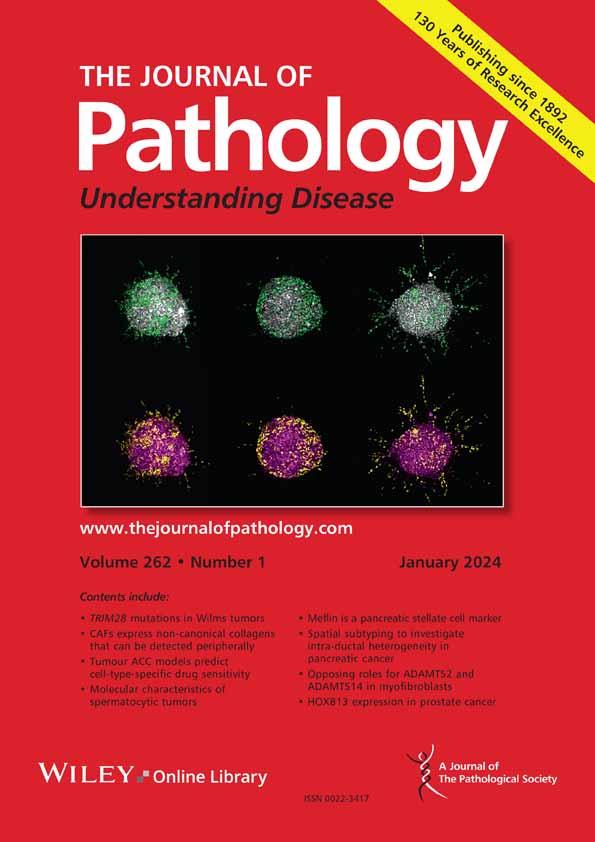下载PDF
{"title":"利用体外小基因剪接法对非典型CNGB3变异进行综合功能剪接分析。","authors":"Katharina Rawnsley, Nicole Weisschuh, Susanne Kohl, Peggy Reuter","doi":"10.1002/path.6431","DOIUrl":null,"url":null,"abstract":"<p>Variants in the <i>CNGB3</i> gene, encoding the B3-subunit of the cone photoreceptor cyclic nucleotide gated channel, are a major cause of autosomal recessive achromatopsia, a rare inherited retinal disease. The mutation spectrum of achromatopsia-associated <i>CNGB3</i> variants comprises all types of mutations, including those that are straightforward to evaluate in molecular genetic diagnostics, such as frame-shifting, nonsense, and canonical splice site variants. Additionally, variants have been identified within splice regions outside the conserved ±1,2 splice site dinucleotides, making their potential impact on disease association challenging to interpret. This poses a major hurdle for clinical interpretation of causality between the patient's genotype and the proposed clinical diagnosis, but also for the inclusion of such patients into clinical trials for gene augmentation therapy, for which only patients with confirmed (likely) pathogenic <i>CNGB3</i> variants are eligible. We here performed comprehensive genetic functional analysis of 21 candidate spliceogenic <i>CNGB3</i> variants—15 reported and 6 novel variants—by means of <i>in vitro</i> minigene splice assays and cDNA analysis, and characterization of spliceogenic events by subcloning, Sanger-sequencing, and capillary fragment analysis. For 16 variants, an impact on splicing was confirmed, supporting the reclassification of 86% of variants of uncertain significance as likely pathogenic or pathogenic according to the ACMG/AMP guidelines. This reclassification enables the confirmation of patients’ genotypes, both retrospectively and prospectively. © 2025 The Author(s). <i>The Journal of Pathology</i> published by John Wiley & Sons Ltd on behalf of The Pathological Society of Great Britain and Ireland.</p>","PeriodicalId":232,"journal":{"name":"The Journal of Pathology","volume":"266 3","pages":"322-336"},"PeriodicalIF":5.2000,"publicationDate":"2025-04-30","publicationTypes":"Journal Article","fieldsOfStudy":null,"isOpenAccess":false,"openAccessPdf":"https://onlinelibrary.wiley.com/doi/epdf/10.1002/path.6431","citationCount":"0","resultStr":"{\"title\":\"Comprehensive functional splicing analysis of non-canonical CNGB3 variants using in vitro minigene splice assays\",\"authors\":\"Katharina Rawnsley, Nicole Weisschuh, Susanne Kohl, Peggy Reuter\",\"doi\":\"10.1002/path.6431\",\"DOIUrl\":null,\"url\":null,\"abstract\":\"<p>Variants in the <i>CNGB3</i> gene, encoding the B3-subunit of the cone photoreceptor cyclic nucleotide gated channel, are a major cause of autosomal recessive achromatopsia, a rare inherited retinal disease. The mutation spectrum of achromatopsia-associated <i>CNGB3</i> variants comprises all types of mutations, including those that are straightforward to evaluate in molecular genetic diagnostics, such as frame-shifting, nonsense, and canonical splice site variants. Additionally, variants have been identified within splice regions outside the conserved ±1,2 splice site dinucleotides, making their potential impact on disease association challenging to interpret. This poses a major hurdle for clinical interpretation of causality between the patient's genotype and the proposed clinical diagnosis, but also for the inclusion of such patients into clinical trials for gene augmentation therapy, for which only patients with confirmed (likely) pathogenic <i>CNGB3</i> variants are eligible. We here performed comprehensive genetic functional analysis of 21 candidate spliceogenic <i>CNGB3</i> variants—15 reported and 6 novel variants—by means of <i>in vitro</i> minigene splice assays and cDNA analysis, and characterization of spliceogenic events by subcloning, Sanger-sequencing, and capillary fragment analysis. For 16 variants, an impact on splicing was confirmed, supporting the reclassification of 86% of variants of uncertain significance as likely pathogenic or pathogenic according to the ACMG/AMP guidelines. This reclassification enables the confirmation of patients’ genotypes, both retrospectively and prospectively. © 2025 The Author(s). <i>The Journal of Pathology</i> published by John Wiley & Sons Ltd on behalf of The Pathological Society of Great Britain and Ireland.</p>\",\"PeriodicalId\":232,\"journal\":{\"name\":\"The Journal of Pathology\",\"volume\":\"266 3\",\"pages\":\"322-336\"},\"PeriodicalIF\":5.2000,\"publicationDate\":\"2025-04-30\",\"publicationTypes\":\"Journal Article\",\"fieldsOfStudy\":null,\"isOpenAccess\":false,\"openAccessPdf\":\"https://onlinelibrary.wiley.com/doi/epdf/10.1002/path.6431\",\"citationCount\":\"0\",\"resultStr\":null,\"platform\":\"Semanticscholar\",\"paperid\":null,\"PeriodicalName\":\"The Journal of Pathology\",\"FirstCategoryId\":\"3\",\"ListUrlMain\":\"https://pathsocjournals.onlinelibrary.wiley.com/doi/10.1002/path.6431\",\"RegionNum\":2,\"RegionCategory\":\"医学\",\"ArticlePicture\":[],\"TitleCN\":null,\"AbstractTextCN\":null,\"PMCID\":null,\"EPubDate\":\"\",\"PubModel\":\"\",\"JCR\":\"Q1\",\"JCRName\":\"ONCOLOGY\",\"Score\":null,\"Total\":0}","platform":"Semanticscholar","paperid":null,"PeriodicalName":"The Journal of Pathology","FirstCategoryId":"3","ListUrlMain":"https://pathsocjournals.onlinelibrary.wiley.com/doi/10.1002/path.6431","RegionNum":2,"RegionCategory":"医学","ArticlePicture":[],"TitleCN":null,"AbstractTextCN":null,"PMCID":null,"EPubDate":"","PubModel":"","JCR":"Q1","JCRName":"ONCOLOGY","Score":null,"Total":0}
引用次数: 0
引用
批量引用





 求助内容:
求助内容: 应助结果提醒方式:
应助结果提醒方式:


